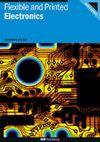The effect of conductive ink alternation on the sustainability and functioning of printed electronics
IF 3.2
4区 工程技术
Q3 MATERIALS SCIENCE, MULTIDISCIPLINARY
引用次数: 1
Abstract
The demand for printed electronics (PE) is expected to increase for improved functionality and autonomy of products in the context of the Internet of Things, especially for sensing and communication. With this trend, the environmental performance of novel technologies is of growing importance, and researchers are exploring ways to make them more environmentally friendly using bio-based substrates and additive printing methods. Conductive inks have the highest environmental impact in the life cycle of PE, and there are two options to decrease the impact: increase recycling rates or replace commonly used silver inks with less impactful materials such as copper or graphite. With the current mixed waste management system, a higher recycling rate for silver is not achievable. Copper and graphite have a lower environmental impact than silver, however, the electrical conductivity of copper and graphite inks is lower than silver ink. This article introduces a double-parameter comparison to simultaneously assess the environmental and electrical conductivity of PE using three inks of silver, copper, and graphite inks. Then based on the technical feasibility, this study proposes suitable applications for each substrate and ink combination.导电油墨交替对印刷电子产品的可持续性和功能的影响
在物联网的背景下,对印刷电子产品(PE)的需求预计将增加,以提高产品的功能和自主性,尤其是在传感和通信方面。随着这一趋势,新技术的环保性能越来越重要,研究人员正在探索使用生物基基底和添加剂印刷方法使其更环保的方法。导电油墨在PE的生命周期中对环境的影响最大,有两种选择可以减少这种影响:提高回收率或用铜或石墨等影响较小的材料取代常用的银油墨。根据目前的混合废物管理系统,无法实现更高的银回收率。铜和石墨对环境的影响比银低,然而,铜和石墨油墨的电导率比银油墨低。本文介绍了使用银、铜和石墨三种油墨进行双参数比较,以同时评估PE的环境和导电性。然后在技术可行性的基础上,本研究提出了适合每种基材和油墨组合的应用方案。
本文章由计算机程序翻译,如有差异,请以英文原文为准。
求助全文
约1分钟内获得全文
求助全文
来源期刊

Flexible and Printed Electronics
MATERIALS SCIENCE, MULTIDISCIPLINARY-
CiteScore
4.80
自引率
9.70%
发文量
101
期刊介绍:
Flexible and Printed Electronics is a multidisciplinary journal publishing cutting edge research articles on electronics that can be either flexible, plastic, stretchable, conformable or printed. Research related to electronic materials, manufacturing techniques, components or systems which meets any one (or more) of the above criteria is suitable for publication in the journal. Subjects included in the journal range from flexible materials and printing techniques, design or modelling of electrical systems and components, advanced fabrication methods and bioelectronics, to the properties of devices and end user applications.
 求助内容:
求助内容: 应助结果提醒方式:
应助结果提醒方式:


